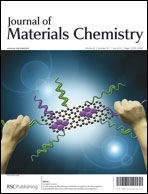We reported the fabrication of a highly sensitive, fast, and thermally switchable humidity sensor based on a β-Ga2O3–amorphous-SnO2 core–shell microribbon, which was synthesized via a simple one-step chemical vapour deposition. The as-grown microribbons were investigated by scanning electron microscopy (SEM), energy dispersive X-ray spectroscopy (EDX), X-ray photoelectron spectroscopy (XPS), and X-ray diffraction (XRD) and the results indicated that the microribbon has a well-defined core–shell structure with β-Ga2O3 in the core and amorphous SnO2 in the shell. At 25 °C, the conductivity of the humidity sensor at 75% relative humidity (RH) was three orders of magnitude larger than that in dry air (5% RH). The response time and recovery time were ∼28 and ∼7 s, respectively, when RH was switched between 5 and 75%. Interestingly, by changing the temperature between 12 and 40 °C at 75% RH, the sensitivity can be tuned between ∼105 (12 °C) and ∼102 (40 °C). Typical thermally switchable properties of β-Ga2O3–amorphous-SnO2 core–shell microribbons at 75% RH were demonstrated using a heating–cooling cycle between 20 and 30 °C. The possible mechanisms have been proposed based on the novel core–shell structures and water adsorption–desorption processes. Our findings pave the way for new types of humidity sensors and thermal switches.

You have access to this article
 Please wait while we load your content...
Something went wrong. Try again?
Please wait while we load your content...
Something went wrong. Try again?


 Please wait while we load your content...
Please wait while we load your content...